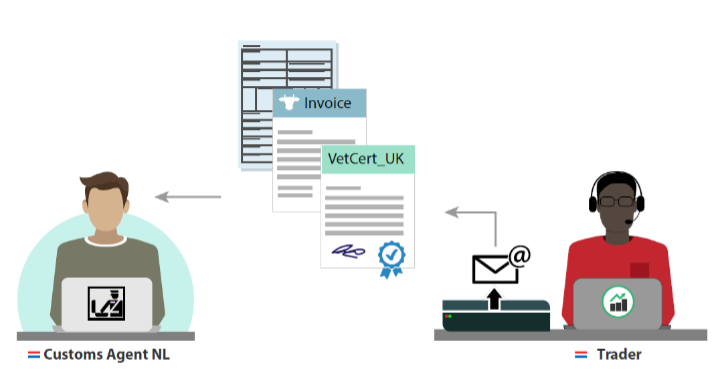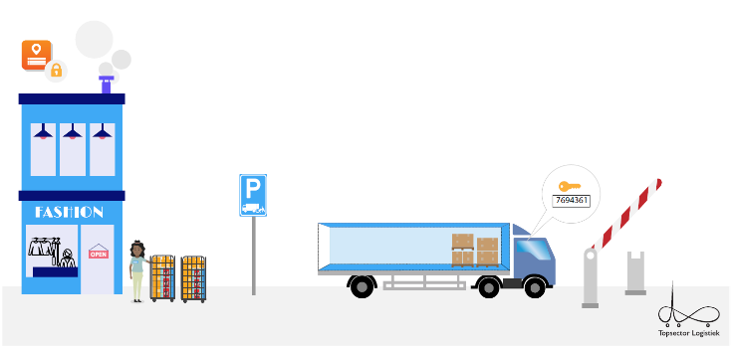7. The dutch Basic Data sharing Infrastructure - Putting theory into practice
In the Netherlands, companies and public authorities increasingly want to use the potential and advantages of federated data sharing. For logistics, the federative data sharing approach has been identified as Basic Data Sharing Infrastructure (BDI) . The BDI features as the cornerstone of the implementation of the national Digital Transport Strategy, a White paper published in 2018. The BDI has a strong relation with the work of the EU DTLF and the FEDeRATED project. The BDI has both a theoretical and practical orientation. The challenge is to effectively put theory into practice and develop viable business cases.
The BDI can be described as a federated infrastructure provision that allows authorized companies and public authorities to use another's data made available based on a common understanding and governance of applicable technical applications and a publish and subscribe approach (pull). It provides for basic functions in the field of language, access, identity and findability. The BDI delivers communication protocols and so-called BDI nodes. The BDI nodes enable platform and system interoperability allowing full connectivity for all operational services.
Although the BDI is still under construction, it's approach already serves as a reference model for many Dutch stakeholders aimed at realizing data driven logistics. In addition, the BDI assists a great variety of national multimodal freight transport and logistic innovation programs towards a paperless transport and data sharing practices. Often, these programs focus on developing cooperation between governments and the business often involving the research community. Since 2015, the ‘Topsector Logistics (TSL) fosters public private partnership for innovative logistics. In its 2022-2023 programming, TSL aims to implement and scale the BDI based onto various business cases. To mention a few:
The first TSL business case deals with the import of cow milk: - many parties are involved, many transactions are made. In addition, a wide variety of compliance data on the origin of the cargo, the performance of the transport and the safety of the goods must be processed towards inspectorates. Currently, this is mostly executed through paper requiring human coordination to check the validity of the information and the status of the different shipments in the supply chain. TSL experiments on a federative data sharing approach - implementing the BDI approach - to replace the human involvement by machines. 
The second TSL business case deals with the sharing of data of ordered goods to optimize delivery planning Relating many different delivery addresses. Each address has its own requirements, preferences and opening hours. Orders are often placed in peaks during the week. This leads to overload for the logistics partner, half empty trucks and unnecessary redundancies. The remedy would be to spread deliveries over time,

To spread deliveries in a 24/7 approach, supply chain partners are offered the opportunity to select the relevant and confidential data on pick-up and delivery addresses, time windows, and specific restrictions available in their own ‘delivery profile’. When orders have been placed, the participants can authorize suppliers and logistic partners to consult and match these profiles. In this way, the logistics process can be simplified and the greening of transport can be supported.
1. The theory of networks
Scale free networks, trust and machine-to-machine communication.
Since the beginning of this century, the science of networks has grown strongly. Computers in networks made it possible to determine how people in a network communicate. It seems that one type of structure often occurs and strongly differs from traditional hierarchical and star-oriented (platform) networks: the ‘scale free network’ (Albert-László Barabási, 2002).
Scientists mention a couple of worthwhile characteristics that make such a scale free network very valuable in highly developed societies. First of all, these types of networks have high redundancy and less vulnerability. There is always a way to reach one another and hostile parties can take over a certain node, but participants can bypass this. Secondly, there is much freedom to change communication patterns and try new and innovative services without central authorization. Finally, participants can reach each other in very few steps. Compare a hierarchical and star network, in which the nodes play a central role and gain much power.

In this kind of network-societies, participants are independent and dependent in the same time. Independent in making own choices, but dependent to fulfill their needs. This leads to very high needs for communication. To make agreements, to coordinate activities, to synchronize information and, very important, to trust each other in compliancy. It has been proven that, by frequent and long-term interaction, people can only maintain a stable relation of trust with 150 people at the maximum.The logistic system and supply chains consist of many more actors than 150. So, to secure trust, we have to institutionalize it.
In a modern network society, a lot of communication has been replaced by computers. Telecommunication and digitization have strongly improved the ability to make agreements and coordinate activities. E-mail and chats replaced paper letters. But, what about the synchronization of information? In reality, humans are essential chains between automized systems. Look at the daily practice in supply chain management: telephone, e-mail and chat are often use to verify if the information received, is correct and reliable. In addition, information in one system has to be retyped into another system. This counts for invoices into the administration of more supply chain partners, bills of lading in planning systems, itineraries in board computers of trucks and so on. In these processes, mistakes are often made, which leads to hick-ups and delays in supply chain management. Wouldn’t it be nice that this will be history? That computers communicate directly with each other and consult each other at the source of data? Easy, with the availability of the Internet, not?
From platforms to federative data sharing
Unfortunately, it isn’t so easy to let computers of different organizations, active in different modalities, in different supply chains with different jurisdictions and different data standards to communicate with each other. These computers need to know each others existence, address, front door, language, meaning of concepts, services they offer and, important, if they can trust each other. The classic reply on these complexities is the set up of platforms which tackles them: a computer in the middle. Trust, services and sometimes also the data are transferred to the platform. But this leads to star-networks. Monopoles of nodes, vulnerability for attacks and breakdowns, mostly commercial interests and difficulties to innovate as one single participant in such a network. These are exactly the things which can be addressed better with a scale free network in which each participant can make his connections with other participants and where the functions are available which a platform normally takes care of: federative data sharing.
Federative data sharing is small step for technicians, but constitutes a giant leap for governments and supply chain partners. First of all, federative data sharing is voluntarily. There is no hierarchical ‘boss’. Each party makes its own investments. Secondly, everybody makes his own connections with other parties. Look at the internet: everybody can set up a server and let the whole world look at documents on that server via a browser. Maybe the most important challenge in terms of mutual trust between the machines is that every participant needs to comply with a minimum of technical and procedural agreements: the ‘scheme’. Some basic functions need to be fulfilled, for example registers, notaries and a common language: semantics and ontology.
2. Putting theory into practice
In the Netherlands, two FEDeRATED living labs are executed and contribute to the BDI development. The BDI will develop a toolbox and manual allow different parties the opportunity to start understanding the BDI concept and adapt their IT systems in a BDI manner. Between 2021-2025, the initial services for all four transport modes, as well as the multimodal transport operations,will be developed in real-world applications, directly involving the business community. These services will relate to container, cargo, transport tracking system applications. The ambition is to acquaint about 2.500 companies with these real-world applications, sowing the seeds to grow an initial and sustainable user base for upscaling data sharing practices.
The first movers towards the implementation of the BDI is a ‘coalition of the willing. Their discussions started in 2011 within the framework of the implementation of the Maritime Single Window project supported by Topsector Logistic. In 2017 they were able to set their cooperation engine into a second and third gear. The parties are the Port of Rotterdam, Amsterdam Airport Schiphol, the Port Community Systems Portbase and Cargonaut and Dutch Customs will be the ‘first movers’ onto the BDI and will set up data sharing living labs with relevant participants on goods- and transport following systems, the expected unloading moments of containers in ports, trust frameworks within BDI and multimodal airfreight chains.
The freight corridor approach: living labs and co creation with decentral communities
A seamless flow of goods between mainports and hinterland is of major importance to the Dutch logistic system and economy. On a national corridor scale, twelve clusters comprising essential logistic nodes are under development. The local user groups (community) will be connected to identify digital challenges problem and find common solutions. The next step will be to develop common operational and information processes (protocol) and the BDI should enable data to be shared in order to provide for new services. Community data hubs or data spaces are most likely to emerge. Compliancy with the BDI-scheme is necessary to make these spaces interoperable. Use cases will serve as practical examples to interact and commit a multitude of stakeholders.
Let’s get IT done
The outlines of a scale free, federative network of platforms in logistics ere emerging. In the Netherlands, a prototype of a BDI node is ready for use in Living Labs. The next five years are crucial. increasingly, the energy is geared towards building a BDI based network. Supporting programmes are emerging. Cooperation agreements are being shaped. The main complexity is not the IT. It is rather the complexity of supply chains, where many parties and many different legacies are involved. System adaptability is essential. Let’s start a fire. Let’s get IT done.
Nanne Onland (CEO Seamless International B.V. ) This email address is being protected from spambots. You need JavaScript enabled to view it. - Herman Wagter (program manager Topsector Logistic) This email address is being protected from spambots. You need JavaScript enabled to view it. - Sjoerd Boot (project manager Basic Data Infrastructure - Dutch Ministry of Infrastructure and Water Management) This email address is being protected from spambots. You need JavaScript enabled to view it.
[1] The Dunbar Number as a Limit to Group Sizes (lifewithalacrity.com)
- Hits: 3384
